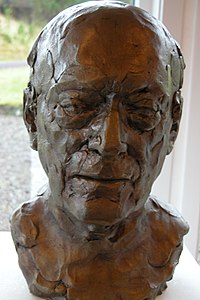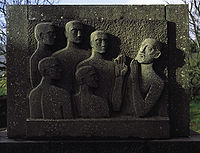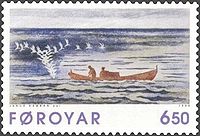Janus Kamban


Janus Kamban (born September 10, 1913 in Tórshavn , Faroe Islands ; † May 2, 2009 ibid) was a Faroese sculptor and graphic artist .
Life
Janus Kamban was considered the first and most important sculptor in the country. He went in 1930 to Copenhagen at the Royal Danish Academy of Fine Arts , in order to study painting, but soon decided otherwise, and attended from 1932 to 1935 and from 1938 to 1940, the sculptor Academy of Fine Arts, where he with Professor Ejnar Utzon-Frank studied, for the he later also worked. Study trips in the 1930s took him to Paris , Florence , Oslo and Stockholm .
In his Copenhagen studio he organized the first exhibition of Faroese art in Denmark. In addition to his own works by Gudmund Hentze , Sámal Joensen-Mikines , Elinborg Lützen , Ruth Smith and Ingolf Jacobsen were on view.
During the Second World War he felt like his compatriots, who were also the first generation of Faroese artists to study in Copenhagen and were forced to stay in German-occupied Denmark while the Faroe Islands were occupied by Great Britain. In August 1945 Kamban returned with the first ship, the Århus , from Copenhagen to the Faroe Islands.
Once there, he immediately established himself as the sculptor. His first monumental work was Móðurmálið (the mother tongue) in 1948 made of native basalt as an anniversary memorial for VU Hammershaimb , who created the Faroese written language in 1846 . One of the four inscriptions reads:
- 1846
- LEGÐI
- VU HAMMERSHAIMB
- LUNNAR
- UNDIR MÓÐURMÁL OKKARA
This literally means: "In 1846, VU Hammershaimb put logs under our mother tongue" - as an allusion to the logs used to move boats ashore. This monument stands today at the entrance to the Viðarlundin á Debesartrøð park in Tórshavn (JC Svabos gøta at the National Library of the Faroe Islands ).
The bronze bust for the politician and lawyer Niels Winther (1822–92) in the entrance to the state library is much more visible . The sculpture man and woman from 1971 in the Tórshavner pedestrian zone Niels Finsens gøta is known to every visitor to the city.
An example of building art is the cement relief Søgumaðurin (the storyteller) from 1956 on the facade of the municipal school in Tórshavn. At 3.8 × 2.9 meters, it was his most monumental work to date. Four children crowd around the storyteller, one of which he is holding in his arms.
When choosing his subjects, Janus Kamban concentrates on everyday and concrete things of island life: seamen, milkers, Faroe boats , sheep, pilot whales, the Faroese chain dance and so on. His materials are plaster of paris , cement , baked clay , wood , basalt and bronze . His monuments can be found all over the Faroe Islands.
Smaller sculptures and busts by Janus Kamban can be found in a permanent exhibition in the Art Museum of the Faroe Islands , of which he was first chairman from 1969 to 1978, when it was still called Listaskálin (Art Gallery). Perhaps his best-known sculpture there is Tvílemba (ewe with lamb) made of cement from 1955 (photo), as a photo of her was sent to stamp collectors all over the world as the cover of a brochure by Postverk Føroya in 1996 . The poet from 1936 is none other than Hans Andrias Djurhuus . Elinborg from 1937 is his artist colleague Elinborg Lützen when she was 18 and was just starting to study. A photo of this bust can be found in the Dansk Kvindebiografisk Leksikon (Danish Women's Biographical Lexicon).
In addition to his sculptures, he also created graphics, specializing in linocut . Numerous book illustrations, posters, company logos and also three postage stamps come from his hand.
The Faroese painter Torbjørn Olsen immortalized his artist colleague in 1991 in a portrait painting (105 × 80 cm, oil, Faroe Museum of Art). In 1993, on the occasion of his 80th birthday, Kamban was honored with a special exhibition by the Art Museum of the Faroe Islands, which was followed in 1995 by the book about his life and work by Gunnar Hoydal .
From 1970 until his death he lived in his own house on the coast (Yviri við Strond in Tórshavn) with a view of Nólsoy , which was built according to his specifications in a classic style with black tarred outer walls and a grass roof. At the age of 85, Janus Kamban fell off his bike and broke his right hand, which never healed properly. This ended his career as an artist.
See also: Faroese art
literature
- Gunnar Hoydal : Janus Kamban. Listasavn Føroya, Tórshavn 1995. (Faroese)
- Bárður Jákupsson : Færøernes Billedkunst. Atlantia (Denmark) 2000. (Danish)
- Don Brandt: More stories and stamps from the Faroe Islands. Postverk Føroya, Tórshavn 2006. (Chapter 16 covers several pages with Kamban)
Web links
- Art.fo - Art Museum of the Faroe Islands via Janus Kamban
- Wichgrafik.dk - Photos for the book by Gunnar Hoydal (by Ole Wich )
Individual evidence
| personal data | |
|---|---|
| SURNAME | Kamban, Janus |
| BRIEF DESCRIPTION | Faroese sculptor and printmaker |
| DATE OF BIRTH | September 10, 1913 |
| PLACE OF BIRTH | Tórshavn , Faroe Islands |
| DATE OF DEATH | May 2, 2009 |
| Place of death | Tórshavn , Faroe Islands |


